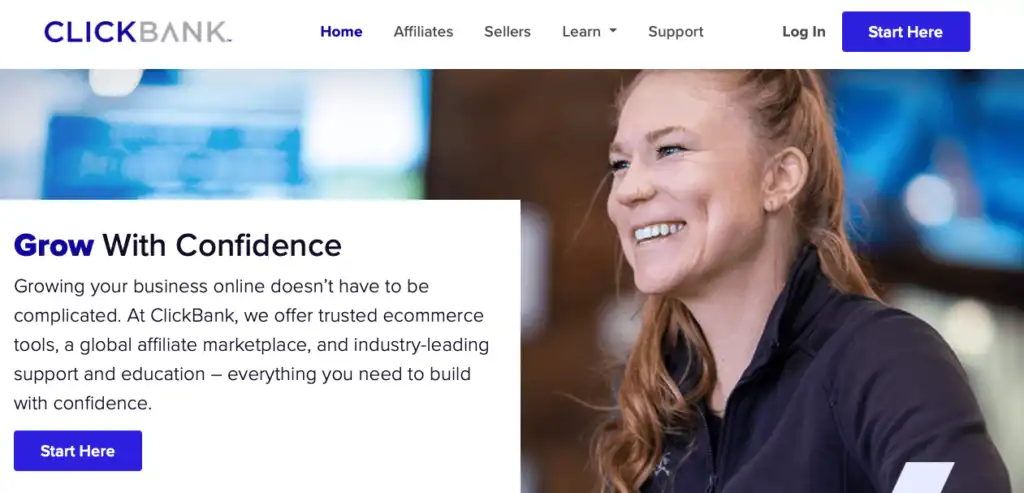Trying to make money online can be a bit of an overwhelming prospect. After all, you have a lot of options at your disposal. You could make an online store but need a product to sell. You could make YouTube videos, but it takes a long time to become profitable. And you could start a blog, but relying solely on ad revenue likely won’t be enough.
That’s why affiliate marketing is such a great option, and it can fill in the gaps for every other online monetization scheme and provide you with a more stable source of income.
But what is affiliate marketing, exactly? And how does it work?
Those questions (and more) are precisely what we’ll endeavor to answer here today.
Let’s jump right in.
Affiliate Marketing: A Definition
Before we can get into the specifics, it’s important to lay out definitions. So what is affiliate marketing, anyway? According to Investopedia, affiliate marketing is a process that allows people to earn a commission for promoting a product or service created by someone else.
This can be done via traditional ads you place on your website (or share on social media). When a customer uses your unique link or inputs a code you provide, it’ll tell the company for which you’re an affiliate that you’ve sent a sale their way. Then at the end of a designated pay period, you’ll receive a payout of your total earnings.
Affiliate programs are typically free, so the investment is quite low, and the payouts can be high – especially if the product or service you’re promoting is a good fit for your audience and if your website, social channels, YouTube channel, or what have you receive a fair amount of traffic already.
How Does Affiliate Marketing Work?

We’ve touched on it in the definition section, but you should know how affiliate marketing programs work. So let’s break that down now.
After signing up for an affiliate program, you’ll be provided with assets you can use to promote the product or service. You’ll also be assigned a unique link that will allow the program to identify sales your website directed to them. The program provider keeps tabs on all affiliate sales made so than at the end of their designated pay period. You can be paid out the agreed-upon commission rate per sale.
Just to be extra clear, the process plays out like this:
- You sign up for an affiliate program of your choosing.
- You place the provided assets (with your assigned link/code) on or in your website, blog, YouTube video description, social media posts, podcast, etc.
- Someone browsing online comes across your content, clicks your affiliate link, or uses your affiliate code. If a link is clicked, a cookie is logged in the potential customer’s web browser, which helps to ensure any purchase they make on the affiliate site is connected back to you – even if they go to another site first before finalizing a selection.
- They make a purchase.
- The affiliate program you signed up for makes a note of this transaction.
- Once the purchase is finalized (payment verified), your commission fee is applied to your affiliate account.
- The commission is paid to an account you specify on the affiliate program’s standard schedule. Commissions can vary. For some programs, it’s a fee based on the percentage of the total purchase. For others, it’s a flat referral fee.
There may be slight variations between how some affiliate programs do things, but this is how it generally goes.
Types of Affiliate Marketing to Be Aware Of
There are a handful of different types of affiliate marketing strategies out there you should know about. And they mostly have to do with your relationship with the affiliate products – less about the products themselves. Let’s review them now:
Unattached affiliates:
This is a situation where you promote products and services you aren’t familiar with and aren’t connected to your niche. You should sign up for one or several affiliate programs and hope that at least one resonates with your audience. Then they’ll click on the link and hopefully make a purchase.
Related affiliates:
This describes situations where you promote a product or service you don’t use yourself but is related to your niche and may interest your audience. The fact that the item interests your audience is great – it’s much more likely you’ll earn a commission on related products. However, using your brand and the authority you’ve built up in your niche is risky to recommend a product for something you haven’t tried. If it goes badly, you could squander your audience’s trust.
Involved affiliates:
The last category of affiliates is those who are considered “involved.” This refers to those who only become affiliates for products and services they’ve personally used and think are high quality. This is the best approach to affiliate marketing. You’re not putting your reputation or trustworthiness on the line; instead, you’re using the authority you’ve built up over time to make genuine recommendations to your audience. This is more work, but it’s also more worthwhile in the end and often leads to a much higher conversion rate.
Affiliate Marketing Monetization Options
Another thing we need to discuss is the monetization options for affiliate marketing. Some people earn just a few dollars per month for their efforts, while others have made affiliate marketing their sole income and rake in thousands of dollars. So what gives? What’s the difference here, and how is income determined?
Let’s break it down.
How you earn money as an affiliate marketer depends on the affiliate program you’re working with. So, if you work with multiple programs, you may earn money in several ways. You may hear affiliate programs refer to their approach to this as a conversion type, a pricing model, a commission rate, or a payout. It just depends on the company and its preferences.
The two most common ways to trigger a commission are to be paid per sale or action. Let’s take a look at these two monetization methods:
- Pay per sale. This describes situations where — you might’ve guessed – you’ll receive a commission for each sale you direct to the affiliate company. It’s a straightforward transaction. A visitor to your site clicks on a link makes a purchase, and you receive a commission.
- Pay per action. This describes situations where you earn a commission each time a visitor to your site completes an action on the affiliate company’s website. The action can vary widely and include things like clicking a link, submitting a form, signing up for an email newsletter, signing up for a free trial, etc.
Other payment models exist for affiliate programs, like pay-per-click programs, pay-per-lead, and pay-per-install.
The amount you earn per affiliate sale depends on the product or service you’re promoting. A high-ticket item will likely have a higher commission rate. But again, it depends on the affiliate program in question. Be sure to review the specifics and the fine print of any program you’re interested in before signing up to see if the commission rate will be worth your time and effort.
How to Become an Affiliate Marketer
Now that we’ve answered some of your biggest questions about affiliate marketing, we can move on to how to get started in this space. A brief tutorial follows for those just getting started as affiliate marketers.
Step 1: Figure Out What Platform You’ll Use as an Affiliate
Before you do anything else, you need to figure out what platform you’ll use to drive traffic to an affiliate company’s site. Often, people will turn their existing blogs into their affiliate marketing platform. And this can work extremely well if you already have a decent audience.
Or, you could create a brand new website covering a topic in a highly profitable niche with many related affiliate programs. These websites might be blogs, magazines, or even review websites comparing products. Such sites give you many opportunities to promote affiliate products organically.
You could always make YouTube videos if you don’t want to write content. The description box below your videos is a great place to include an affiliate link or two – especially if you discussed or reviewed the product mentioned in your video. The same concept applies to social media sites as well. You can also use your social platforms, like Instagram or TikTok, to promote affiliate products.
Whichever platform you choose, make sure you use it often anyway. This will save you a lot of headaches trying to figure out the finer details of how to use it and instead allow you to focus on simply making engaging content with it.
Step 2: Pick Your Topic or Niche
With a platform in mind, you can focus on what you’ll discuss. Selecting a topic or niche will help you in several ways:
- It narrows down your search for affiliate programs.
- Limits the scope of your talk, simplifying idea generation.
- It improves your search engine optimization efforts.
It’s a good idea to steer clear of the huge niches, especially in business or technology topics. Yes, they have high-priced affiliate products to promote, but they’re also hugely competitive and hard to break into. Choosing a niche with less competition – but a decently sized audience- is a much better idea – to build your affiliate marketing efforts around.
The amount of targeted web traffic you receive will determine the overall success of your affiliate marketing efforts, so keep that in mind when making a niche selection.
Step 3: Pick an Affiliate Program
The last thing you need to do before starting is select an affiliate program. Yes, you can sign up for several and promote numerous products, but starting with just one is best to avoid getting overwhelmed.
Many companies have affiliate programs, so if you’re aware of the one you’re interested in related to your niche already, by all means, pursue it. However, if you’re unsure, you may consider browsing an affiliate marketplace to find a suitable program. A few popular options include ClickBank, ShareASale, CJ Affiliate, and AvantLink. These have solid reputations as well-known options for finding an affiliate product to promote across various niches.

If you want the flexibility to promote a wider range of products – if you create DIY projects or offer hands-on tutorials, for instance – signing up as an Amazon Associate is a good idea, too. That way, you can directly link to the products you use in your projects and earn a commission from those looking to complete the same project.

Many individual companies offer affiliate programs, too. For instance, HubSpot offers a 90-cookie and a 15% commission rate. The Blue Apron meal kit service offers a $15 commission per sale. And the list goes on.
Get Started with Affiliate Marketing Now
Now that you know what affiliate marketing is, how it works, and how to get started, there’s nothing left to do but put in the work for real.
Good luck!


Leave a Comment